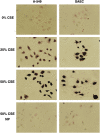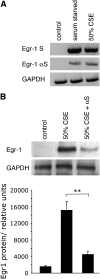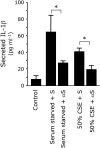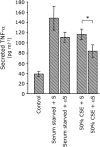Cigarette smoke-induced Egr-1 upregulates proinflammatory cytokines in pulmonary epithelial cells
- PMID: 16601242
- PMCID: PMC2643284
- DOI: 10.1165/rcmb.2005-0428OC
Cigarette smoke-induced Egr-1 upregulates proinflammatory cytokines in pulmonary epithelial cells
Abstract
Chronic obstructive pulmonary disease (COPD) is the fourth leading cause of death worldwide and is a progressive and irreversible disorder. Cigarette smoking is associated with 80-90% of COPD cases; however, the genes involved in COPD-associated emphysema and chronic inflammation are poorly understood. It was recently demonstrated that early growth response gene 1 (Egr-1) is significantly upregulated in the lungs of smokers with COPD (Ning W and coworkers, Proc Natl Acad Sci 2004;101:14895-14900). We hypothesized that Egr-1 is activated in pulmonary epithelial cells during exposure to cigarette smoke extract (CSE). Using immunohistochemistry, we demonstrated that pulmonary adenocarcinoma cells (A-549) and primary epithelial cells lacking basal Egr-1 markedly induce Egr-1 expression after CSE exposure. To evaluate Egr-1-specific effects, we used antisense (alphaS) oligodeoxynucleotides (ODN) to knock down Egr-1 expression. Incorporation of Egr-1 alphaS ODN significantly decreased CSE-induced Egr-1 mRNA and protein, while sense ODN had no effect. Via Egr-1-mediated mechanisms, IL-1beta and TNF-alpha were significantly upregulated in pulmonary epithelial cells exposed to CSE or transfected with Egr-1. To investigate the relationship between Egr-1 induction by smoking and susceptibility to emphysema, we determined Egr-1 expression in strains of mice with different susceptibilities for the development of smoking-induced emphysema. Egr-1 was markedly increased in the lungs of emphysema-susceptible AKR/J mice chronically exposed to cigarette smoke, but only minimally increased in resistant NZWLac/J mice. In conclusion, Egr-1 is induced by cigarette smoke and functions in proinflammatory mechanisms that likely contribute to the development of COPD in the lungs of smokers.
Figures








Similar articles
-
Cigarette smoke stimulates matrix metalloproteinase-2 activity via EGR-1 in human lung fibroblasts.Am J Respir Cell Mol Biol. 2007 Apr;36(4):480-90. doi: 10.1165/rcmb.2006-0106OC. Epub 2006 Nov 10. Am J Respir Cell Mol Biol. 2007. PMID: 17099140 Free PMC article.
-
Early growth response factor 1 is essential for cigarette smoke-induced MUC5AC expression in human bronchial epithelial cells.Biochem Biophys Res Commun. 2017 Aug 19;490(2):147-154. doi: 10.1016/j.bbrc.2017.06.014. Epub 2017 Jun 8. Biochem Biophys Res Commun. 2017. PMID: 28602698
-
Egr-1 regulates autophagy in cigarette smoke-induced chronic obstructive pulmonary disease.PLoS One. 2008 Oct 2;3(10):e3316. doi: 10.1371/journal.pone.0003316. PLoS One. 2008. PMID: 18830406 Free PMC article.
-
Cigarette smoke-induced pulmonary inflammatory responses are mediated by EGR-1/GGPPS/MAPK signaling.Am J Pathol. 2011 Jan;178(1):110-8. doi: 10.1016/j.ajpath.2010.11.016. Epub 2010 Dec 23. Am J Pathol. 2011. PMID: 21224049 Free PMC article.
-
Cigarette smoke-induced autophagy impairment accelerates lung aging, COPD-emphysema exacerbations and pathogenesis.Am J Physiol Cell Physiol. 2018 Jan 1;314(1):C73-C87. doi: 10.1152/ajpcell.00110.2016. Epub 2016 Jul 13. Am J Physiol Cell Physiol. 2018. PMID: 27413169 Free PMC article.
Cited by
-
Activation of Egr-1 in human lung epithelial cells exposed to silica through MAPKs signaling pathways.PLoS One. 2013 Jul 18;8(7):e68943. doi: 10.1371/journal.pone.0068943. Print 2013. PLoS One. 2013. PMID: 23874821 Free PMC article.
-
Egr-1: new conductor for the tissue repair orchestra directs harmony (regeneration) or cacophony (fibrosis).J Pathol. 2013 Jan;229(2):286-97. doi: 10.1002/path.4131. Epub 2012 Dec 3. J Pathol. 2013. PMID: 23132749 Free PMC article. Review.
-
In utero exposure to second-hand smoke aggravates adult responses to irritants: adult second-hand smoke.Am J Respir Cell Mol Biol. 2012 Dec;47(6):843-51. doi: 10.1165/rcmb.2012-0241OC. Epub 2012 Sep 6. Am J Respir Cell Mol Biol. 2012. PMID: 22962063 Free PMC article.
-
Identification of differentially expressed genes and signaling pathways in chronic obstructive pulmonary disease via bioinformatic analysis.FEBS Open Bio. 2019 Nov;9(11):1880-1899. doi: 10.1002/2211-5463.12719. Epub 2019 Sep 29. FEBS Open Bio. 2019. PMID: 31419078 Free PMC article.
-
Z α1-antitrypsin confers a proinflammatory phenotype that contributes to chronic obstructive pulmonary disease.Am J Respir Crit Care Med. 2014 Apr 15;189(8):909-31. doi: 10.1164/rccm.201308-1458OC. Am J Respir Crit Care Med. 2014. PMID: 24592811 Free PMC article.
References
-
- Voelkel NF, MacNee W. Chronic obstructive lung diseases. Hamilton, ON: B. C. Decker; 2002. pp. 90–113.
-
- Petty TL. COPD in perspective. Chest 2002;121:116S–120S. - PubMed
-
- Sethi JM, Rochester CL. Smoking and chronic obstructive pulmonary disease. Clin Chest Med 2000;21:67–86. - PubMed
-
- Mayer AS, Newman LS. Genetic and environmental modulation of chronic obstructive pulmonary disease. Respir Physiol 2001;128:3–11. - PubMed
Publication types
MeSH terms
Substances
Grants and funding
LinkOut - more resources
Full Text Sources
Other Literature Sources
Molecular Biology Databases

